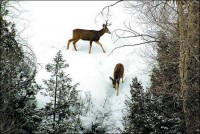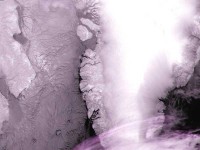Feb 24, 2008
The Coming of a New Ice Age
By Gerald E. Marsh
Contrary to the conventional wisdom of the day, the real danger facing humanity is not global warming, but more likely the coming of a new Ice Age. What we live in now is known as an interglacial, a relatively brief period between long ice ages.
Unfortunately for us, most interglacial periods last only about ten thousand years, and that is how long it has been since the last Ice Age ended. How much longer do we have before the ice begins to spread across the Earth’s surface? Less than a hundred years or several hundred? We simply don’t know.
Even if all the temperature increase over the last century is attributable to human activities, the rise has been relatively modest one of a little over one degree Fahrenheit - an increase well within natural variations over the last few thousand years. While an enduring temperature rise of the same size over the next century would cause humanity to make some changes, it would undoubtedly be within our ability to adapt.
Entering a new ice age, however, would be catastrophic for the continuation of modern civilization. NASA has predicted that the solar cycle peaking in 2022 could be one of the weakest in centuries and should cause a very significant cooling of Earth’s climate. Will this be the trigger that initiates a new Ice Age? We ought to carefully consider this possibility before we wipe out our current prosperity by spending trillions of dollars to combat a perceived global warming threat that may well prove to be only a will-o-the-wisp.

Today’s solar image showing sun is still asleep nearly 12 years from last solar minimum
Gerald Marsh is a retired physicist from the Argonne National Laboratory and a former consultant to the Department of Defense on strategic nuclear technology and policy in the Reagan, Bush, and Clinton Administration.
Feb 17, 2008
Colorado Department of Wildlife Forced to Feed Deer in Eagle County
By Matt Terrell, Eagle County Correspondent
Feeding operations were started because the animals appear to be in desperate condition. Because of a harsh and snowy winter, wildlife managers will start feeding starving deer near Eagle and Wolcott for just the third time in almost 25 years. The consistent, heavy snowfall that’s been so good for the ski slopes has covered up the small plants and shrubs, like sage brush, that deer eat in the winter. Deer don’t store as much fat as elk, so those plants that poke up through the snow are vital to their survival.
Now, the deer are hungry enough to start stripping juniper trees, which have almost no nutrition. It’s a sure sign of desperation, says Randy Hampton, spokesman for the Division of Wildlife. The Division of Wildlife will only consider feeding animals if there’s a chance more than 30 percent of adult female deer will die in a winter. This has only happened in the winters of 1983-1984 and 1996-1997, and it looks like that could happen.

Colorado Department of Wildlife Photo
Feb 17, 2008
Enduring Tajikistan’s Coldest Winter
By Natalia Antelava, BBC, Tajikistan
After suffering its worst winter in 50 years, Tajikistan has finally appealed to the United Nations for aid. But a total loss of electricity is still a possibility, and could have terrible consequences.
In January, as temperatures dropped to a record low of -20C, people started consuming more power to keep warm and the country’s entire energy system began to shut down. In the mountains, rivers froze, leaving hydropower stations without supplies to run their turbines. And in the cities and villages, frozen pipes left millions of people without a source of drinking water. The main reservoir of the country’s biggest hydropower station is slowly but steadily running out of water. It is like a giant bathtub that has been unplugged and, once all of it goes, the whole country could shut down.
At a freezing-cold maternity ward outside Dushanbe, a nurse told me she was terrified of the disaster that a total blackout could bring. Keeping hospital patients warm is extremely difficult. Electricity supplies to her hospital are already scarce and there is no heating. Wrapped up in several blankets, newborns are kept warm with bottles of hot water that hospital staff put in their cribs. The method does not always work. Floating around Dushanbe are horrifying accounts of babies freezing to death in maternity wards, or people on life support, dying during electricity cuts. Read more here.
See the troubles in nearby Afghanistan here and here.
Feb 15, 2008
Deep Freeze in Western Greenland
The ice between Canada and southwestern Greenland has reached its highest level in 15 years. Minus 30 degrees Celsius. That’s how cold it’s been in large parts of western Greenland where the population has been bundling up in hats and scarves. At the same time, Denmark’s Meteorological Institute states that the ice between Canada and southwest Greenland right now has reached its greatest extent in 15 years.
‘Satellite pictures show that the ice expansion has extended farther south this year. In fact, it’s a bit past the Nuuk area. We have to go back 15 years to find ice expansion so far south. On the eastern coast it hasn’t been colder than normal, but there has been a good amount of snow.’

But how do these new reports fit in with continual reports that ice in the Arctic Ocean has been melting at a record rate due to increasing temperatures? And isn’t global warming at the top of the political agenda these years?
Read more here.
Feb 14, 2008
Big Climate’s Strange ‘Science’
By John Atkinson, The Register
Would you trust a software engineer to build a bridge? Climate science is a very, very new field. So new, in fact, that it has had little chance for its assertions to be tested. For example, climate models are being developed with very little ability to test out of sample. Furthermore, the climate science bandwagon has come about solely because of supposed anthropogenic climate change, which means that their funding is intrinsically tied to climate change happening and being man-made. A more self-interested group I could not find anywhere, even looking at the researchers who were paid by big tobacco companies to tell us cigarettes are safe. Of course, astrophysicists and astronomers will happily tell us about global warming on other planets in the solar system, a period of extensive solar activity and the like. But they get poo-pooed just like all the other “real scientists” who have a view. Climate scientists have to disagree with real scientists or they would lose their funding. Finally, why can’t we trust human ingenuity? At the moment, I don’t see that the evidence for anthropogenic climate change is strong enough to wreck our economies to try to change it.
The scientists who interest me in this field are those who can draw on the experience of a lot of people who have come before them. And uniformly in these areas I find scepticism. People who write mathematical models of complex systems for a living tend to find the climate models very unconvincing. Geologists find the arguments very unconvincing. Engineers find the arguments unconvincing. And astrophysicists find the arguments unconvincing. Why? Well the answers are clear: climate groupthink. Read more here.





